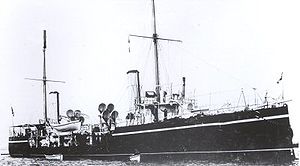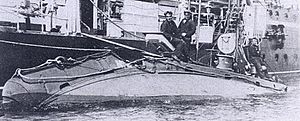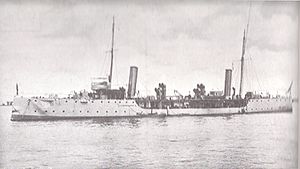HMS Hazard (1894)
 HMS Hazard | |
| Career (United Kingdom) | |
|---|---|
| Name: | HMS Hazard |
| Builder: | Pembroke Dockyard |
| Laid down: | 1 December 1892[1] |
| Launched: | 14 February 1894 |
| Commissioned: | 24 July 1895[1] |
| Fate: | Sunk in collision on 28 January 1918 |
| General characteristics | |
| Class and type: | Dryad-class torpedo gunboat |
| Tons burthen: | 1070 tons |
| Length: | 262 ft 6 in (80.01 m) |
| Beam: | 30 ft 6 in (9.30 m) |
| Draught: | 13 ft (4.0 m) |
| Installed power: | 3,500 ihp (2,600 kW)[1] |
| Propulsion: |
|
| Speed: | 18.2 kn (33.7 km/h) |
| Complement: | 120 |
| Armament: |
|
The sixth HMS Hazard was a Dryad-class torpedo gunboat. She was launched in 1894 and was converted into the world's first Submarine Depot Ship in 1901. She collided with Submarine A3 on 2 February 1912, killing 14 men, and was herself sunk in collision with SS Western Australia on 28 January 1918.
Contents
Design
Ordered under the Naval Defence Act of 1889, which established the "Two-Power Standard", the class was contemporary with the first Torpedo Boat Destroyers. With a length overall of 262 ft 6 in (80.01 m),[1] a beam of 30 ft 6 in (9.30 m)[1] and a displacement of 1,070 tons,[1] these torpedo gunboats were not small ships by the standard of the time; they were larger than the majority of World War I destroyers. Hazard was engined by Fairfield with two sets of vertical triple-expansion steam engines, two locomotive-type boilers, and twin screws. This layout produced 3,500 indicated horsepower (2,600 kW),[1] giving her a speed of 18.2 knots (33.7 km/h).[1] She carried between 100 and 160 tons of coal and was manned by 120 sailors and officers.[1]
Armament
The armament when built comprised two QF 4.7-inch (12 cm) guns, four 6-pdr guns and a single 5-barrelled Nordenfelt machine gun. Her primary weapon was five 18-inch (460 mm) torpedoes, with two reloads.[1] On conversion to a minesweeper in 1914 two of the five torpedoes were removed.[1]
History
On 26 June 1897 Halcyon was present at the Fleet Review at Spithead in celebration of Queen Vicoria's Diamond Jubilee.[2]
"Pacification of Crete"
Hazard was present during 1897 and 1898 at the campaign by the Great Powers to pacify Crete. A council of Naval officers ordered that the Customs House at Candia be turned over to the British in order to initiate a system of export duties. On 6 September 1898 a well-armed mob attacked the small force of soldiers and sailors at the customs house, and concurrently the British camp and hospital at the other end of the town were assaulted. Hazard opened fire on the town with her 4.7-inch guns when no support was provided by the Turkish troops charged with keeping order. The mob turned their attentions on the native Christian community, killing upwards of 1,000 men, women and children. Hazard lost four seamen killed and several wounded; Lieutenant Lewes, the commanding officer of Hazard was promoted to Commander, and Surgeon William Job Maillard was awarded the Victoria Cross. A monument to the killed seaman has been placed in the Upper Barracca at Malta.[3]
Submarine Depot Ship

In 1901[1] she was converted into the world's first Submarine Depot Ship,[4] the only ship of her class to be so converted. Her first captain in the new role was Captain Reginald Bacon, who held the post of "Inspecting Captain of submarine boats". She was despatched to Barrow-in-Furness to take up her new task. In the summer of 1902 Hazard led a group consisting of HM Submarines No.2 and No.3, and Torpedo Boat No.42 to Portsmouth, where, together with Submarines No.1, No.4 and No.5, they formed the First Submarine Flotilla.[4]
Collision with Submarine A3
On 2 February 1912 Hazard, under the command of Lieutenant Charles J C Little, collided with the submerged submarine A3. The submarine was in the process of surfacing during exercises when she was struck;[4] the stricken boat sank with the loss of all 14 personnel on board.[3]
World War I
In August 1914 Hazard was serving as the depot for the Fourth Submarine Flotilla.[2]
Loss
On 28 January 1918 she collided with the hospital ship[2] SS Western Australia in the English Channel[1] and sank off Portland Bill.[2][3]
References
- ↑ 1.00 1.01 1.02 1.03 1.04 1.05 1.06 1.07 1.08 1.09 1.10 1.11 1.12 1.13 1.14 Winfield, Rif; Lyon, David (2003). The Sail and Steam Navy List, 1815-1889. Chatham Publishing. ISBN 978-1861760326.
- ↑ 2.0 2.1 2.2 2.3 "HMS Hazard at the Index of 19th Century Naval Vessels". http://www.pbenyon.plus.com/18-1900/H/02188.html. Retrieved 2009-02-24.
- ↑ 3.0 3.1 3.2 "HMS Hazard at BattleshipsCruisers.co.uk". http://www.battleships-cruisers.co.uk/r_n_gunboats.htm. Retrieved 2009-02-24.
- ↑ 4.0 4.1 4.2 Compton-Hall, Richard (1983). First Submarines. Conway Maritime Press. ISBN 9781904381198. http://books.google.co.uk/books?id=RTL7O8IMFZ0C. Retrieved 2009-02-24.
- Colledge, J. J.; Warlow, Ben (2006) [1969]. Ships of the Royal Navy: the complete record of all fighting ships of the Royal Navy (Rev. ed.). London: Chatham. ISBN 9781861762818. OCLC 67375475.
| ||||||||

